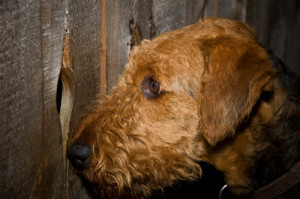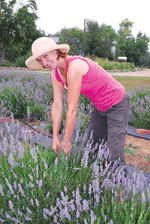Feature Garden: A Place for Paws
04 Jul 2010
This backyard was completely re-landscaped to make it user-friendly for the owner and her dogs. Here is her advice for creating a dog-friendly yard.
Photos by Ryan James One day, Barbee James looked at her backyard terraces flush with flowers, sweeping down a slope to merge with an emerald expanse of open space just beyond the fence. James took in the picturesque scene and knew exactly what she had to do. Rip it out.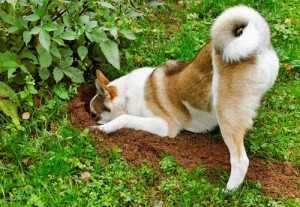 Life had changed; the yard had to go. After 22 years of marriage, James got divorced, got some dogs and realized the original 110-foot-long landscape she’d installed with her husband in Wonderland Lake no longer suited her life.
“I wanted a dog-friendly yard,” James explains. “That yard was not dog friendly. There were no fun activities for the dogs, and the shrubs were so thick the dogs couldn’t even run through them.”
So, like a good dog mama, James revamped her landscape to accommodate her two labradoodles, Jezibella and grown puppy Jasper, and a schnauzer named Sushi (recently deceased). Now that she was single again, “my animals were even more important to me,” says James, who also redid her yard for her peace of mind. “It’s a lot of work to have a dog, and when you work full time the last thing you want to do is go exercise your dog when you get home,” says James, an interior designer who owns Details Design Studio in Boulder. “I wanted a backyard that the dogs could have fun in, play in and be entertained.”
Life had changed; the yard had to go. After 22 years of marriage, James got divorced, got some dogs and realized the original 110-foot-long landscape she’d installed with her husband in Wonderland Lake no longer suited her life.
“I wanted a dog-friendly yard,” James explains. “That yard was not dog friendly. There were no fun activities for the dogs, and the shrubs were so thick the dogs couldn’t even run through them.”
So, like a good dog mama, James revamped her landscape to accommodate her two labradoodles, Jezibella and grown puppy Jasper, and a schnauzer named Sushi (recently deceased). Now that she was single again, “my animals were even more important to me,” says James, who also redid her yard for her peace of mind. “It’s a lot of work to have a dog, and when you work full time the last thing you want to do is go exercise your dog when you get home,” says James, an interior designer who owns Details Design Studio in Boulder. “I wanted a backyard that the dogs could have fun in, play in and be entertained.”
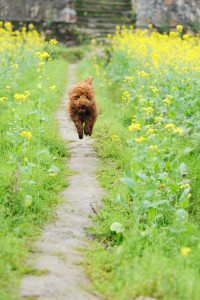 It took a little trial and error to figure out the right elements for her yard, which now has a re-circulating fountain with a 25-foot trough that feeds a 4-foot-wide pond. “Jezi loves to swim and get completely wet, but Jasper’s not a water dog, so I put a platform in the pond for him to stand on,” says James, who uses an all-natural, dog-friendly algae preventive in the pond.
The former terraces blocked access to the lawn below the slope, so James installed sandstone stairs from the upper-level patio to the grass. Surprisingly, the stairs proved to be a bonus dog feature: “They run down the stairs and back up the grass to do a loop, so it’s great exercise for them.”
In addition to the drinking trough, pond and loop, Jezi and Jasper have bedding areas to trample, boulders to jump on, a lawn for ball playing, and an arbor and trees to snooze beneath on hot days. Jasper is “a barker and a digger,” James says, so she incorporated a separate digging spot next to the patio and filled it with potting soil, vermiculite, peat and sand. “I tried to make it soft so he’d like it,” she says, but Jasper still prefers her flowerpots. “He doesn’t do it when the plants are in them, though.
I think he just likes standing above the pot and digging down into it.” Jasper now has his own flowerless pots in his digging area.
It took a little trial and error to figure out the right elements for her yard, which now has a re-circulating fountain with a 25-foot trough that feeds a 4-foot-wide pond. “Jezi loves to swim and get completely wet, but Jasper’s not a water dog, so I put a platform in the pond for him to stand on,” says James, who uses an all-natural, dog-friendly algae preventive in the pond.
The former terraces blocked access to the lawn below the slope, so James installed sandstone stairs from the upper-level patio to the grass. Surprisingly, the stairs proved to be a bonus dog feature: “They run down the stairs and back up the grass to do a loop, so it’s great exercise for them.”
In addition to the drinking trough, pond and loop, Jezi and Jasper have bedding areas to trample, boulders to jump on, a lawn for ball playing, and an arbor and trees to snooze beneath on hot days. Jasper is “a barker and a digger,” James says, so she incorporated a separate digging spot next to the patio and filled it with potting soil, vermiculite, peat and sand. “I tried to make it soft so he’d like it,” she says, but Jasper still prefers her flowerpots. “He doesn’t do it when the plants are in them, though.
I think he just likes standing above the pot and digging down into it.” Jasper now has his own flowerless pots in his digging area.
Not Gone to the Dogs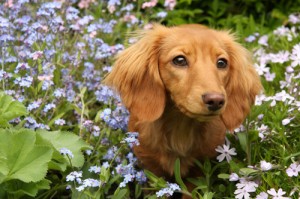
After consulting with garden experts, James found bedding plants that didn’t mind a good trampling. Chief among them are ground covers like thyme and ice plant, and mosses for shady areas. “I have a woolly thyme, a gray thyme and a creeping thyme,” James says. “They’re low-water, they grow fast and fill in, and they take abuse.”
The ground covers also keep the integrity of her planting beds, which are covered in 1.5-inch-diameter gravel. More importantly, the ground cover–gravel combo makes the garden an all-season playground by keeping mud off paws in winter. “All my flower beds have rock on them so the dogs don’t track mud in the house,” James says. “I don’t want to contain the dogs, and I don’t want to wipe off their paws all the time.” With rock, ground covers and grass, “only water gets inside from snow, and that’s a lot easier to deal with than mud.”
What’s harder to deal with is James’ first choice of using pea gravel to cover her beds. The dogs’ paws fling it everywhere. “Trying to keep that little pea gravel out of the grass is a nightmare. I’m always cleaning it out of the yard.” Because she laid it 3-inches deep, it was too difficult to remove it all, so she simply covered the remainder with larger gravel. “I thought the pea gravel would be easier on their paws, but they don’t care,” she says. She didn’t use bark mulch because of the high winds in her location.
Looser, vine-like plants like vinca don’t fare well under paws either, until they’re established. “But purple Japanese iris, tulips, daffodils and daylilies are really sturdy,” she says, adding that denser vines do well, too. (See related article “No-No Plants for Pups”.) Junipers, creeping blue spruce, mugo pine, honey locust, lilacs, alyssum and lavender dot her dog-friendly yard. She supplements these with colorful pots planted with petunias, pansies, geraniums and other annuals. She also installed a bat box to cut down on mosquitoes from the nearby lake that could potentially carry the threat of heartworm.
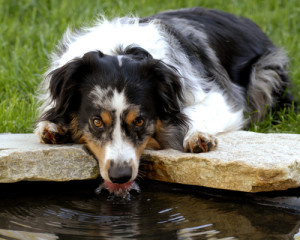 And she endured a hard lesson about metal lawn sculpture: “Jezi cut her leg open on mine; that was a $500 sew-up job on a Sunday,” James says. “So anything metal in the yard is very dangerous for dogs.” To undermine potential threats, she installed rubber-coated edging, planted sturdy trees that won’t snap limbs in winds or snow, and has only fruitless trees and shrubs. “I won’t plant anything with berries,” she says. “I don’t think it’s fair to attract birds into the yard only to have the dogs chase them. Plus, the dogs might eat the berries and get sick.”
James routinely patrols her yard for hazards like bottle caps thrown over the fence by hikers, loose rails and telltale signs of digging under the fence, which she recently increased in height to keep out coyotes.
With all the effort she expends on her dog-friendly yard, is it worth it? “Yes,” she says, “because I personally don’t have to work as hard.” Instead of fretting about trampled blooms, she can relax on the patio with a glass of wine and toss the ball for the dogs. “I want to enjoy my dogs,” she says. “I don’t want to be mad at them if they’ve torn up my yard or done this or that. And I don’t want to pen them up or put them in a dog run. My animals are members of my family, so I would rather have a yard where they can be a part of the family. Life is too short to worry about dogs trampling your plants.”
The parts of her yard she doesn’t want trampled, namely her planting beds, she protects with barriers like low-growing creeping roses and thick juniper hedges. “You don’t want your dog to run rough- shod over everything. You want a yard for you, too. That’s why I have flowerpots for me and barrier plants to keep them out of places I don’t want them in.”
And she endured a hard lesson about metal lawn sculpture: “Jezi cut her leg open on mine; that was a $500 sew-up job on a Sunday,” James says. “So anything metal in the yard is very dangerous for dogs.” To undermine potential threats, she installed rubber-coated edging, planted sturdy trees that won’t snap limbs in winds or snow, and has only fruitless trees and shrubs. “I won’t plant anything with berries,” she says. “I don’t think it’s fair to attract birds into the yard only to have the dogs chase them. Plus, the dogs might eat the berries and get sick.”
James routinely patrols her yard for hazards like bottle caps thrown over the fence by hikers, loose rails and telltale signs of digging under the fence, which she recently increased in height to keep out coyotes.
With all the effort she expends on her dog-friendly yard, is it worth it? “Yes,” she says, “because I personally don’t have to work as hard.” Instead of fretting about trampled blooms, she can relax on the patio with a glass of wine and toss the ball for the dogs. “I want to enjoy my dogs,” she says. “I don’t want to be mad at them if they’ve torn up my yard or done this or that. And I don’t want to pen them up or put them in a dog run. My animals are members of my family, so I would rather have a yard where they can be a part of the family. Life is too short to worry about dogs trampling your plants.”
The parts of her yard she doesn’t want trampled, namely her planting beds, she protects with barriers like low-growing creeping roses and thick juniper hedges. “You don’t want your dog to run rough- shod over everything. You want a yard for you, too. That’s why I have flowerpots for me and barrier plants to keep them out of places I don’t want them in.”

